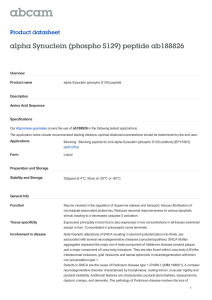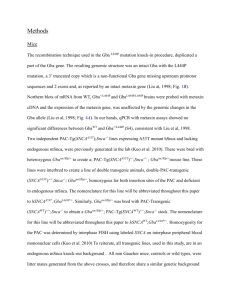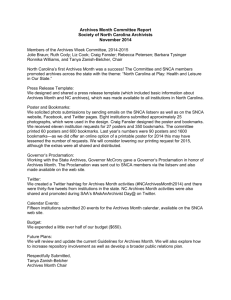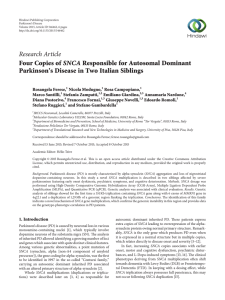Young-Onset Parkinsonism due to
advertisement
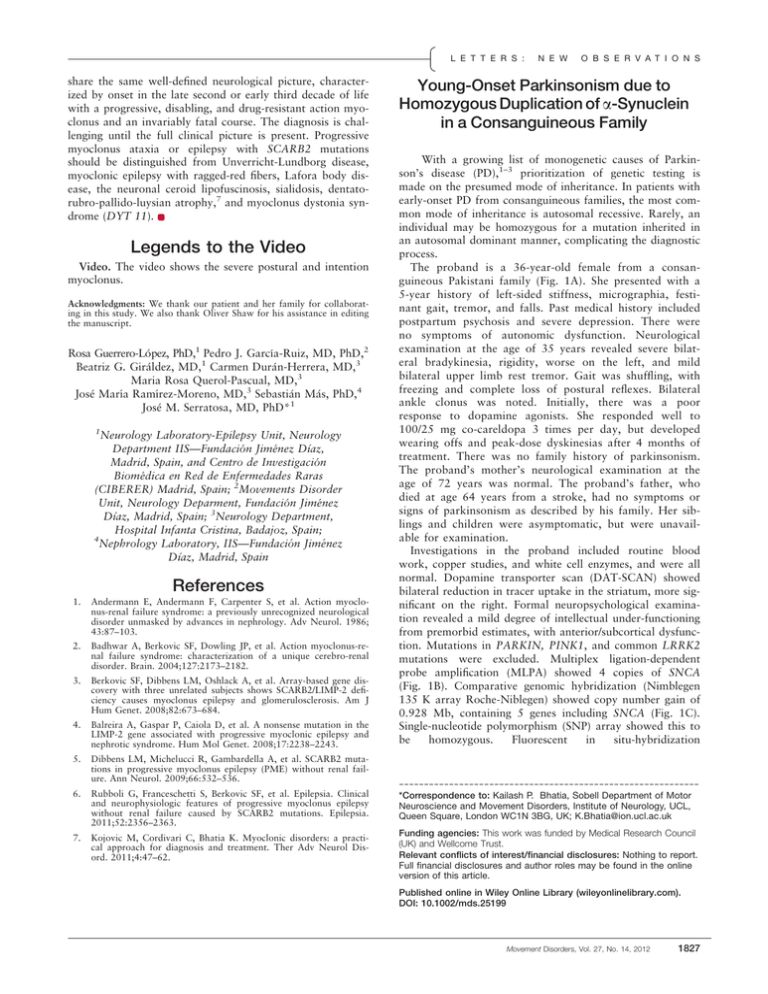
L E T T E R S : share the same well-defined neurological picture, characterized by onset in the late second or early third decade of life with a progressive, disabling, and drug-resistant action myoclonus and an invariably fatal course. The diagnosis is challenging until the full clinical picture is present. Progressive myoclonus ataxia or epilepsy with SCARB2 mutations should be distinguished from Unverricht-Lundborg disease, myoclonic epilepsy with ragged-red fibers, Lafora body disease, the neuronal ceroid lipofuscinosis, sialidosis, dentatorubro-pallido-luysian atrophy,7 and myoclonus dystonia syndrome (DYT 11). Legends to the Video Video. The video shows the severe postural and intention myoclonus. Acknowledgments: We thank our patient and her family for collaborating in this study. We also thank Oliver Shaw for his assistance in editing the manuscript. Rosa Guerrero-L opez, PhD,1 Pedro J. Garcı́a-Ruiz, MD, PhD,2 Beatriz G. Giraldez, MD,1 Carmen Duran-Herrera, MD,3 Maria Rosa Querol-Pascual, MD,3 Jose Marı́a Ramı́rez-Moreno, MD,3 Sebastian Mas, PhD,4 Jose M. Serratosa, MD, PhD*1 1 Neurology Laboratory-Epilepsy Unit, Neurology Department IIS—Fundaci on Jimenez Dı́az, Madrid, Spain, and Centro de Investigaci on Biomedica en Red de Enfermedades Raras (CIBERER) Madrid, Spain; 2Movements Disorder Unit, Neurology Deparment, Fundaci on Jimenez Dı́az, Madrid, Spain; 3Neurology Department, Hospital Infanta Cristina, Badajoz, Spain; 4 Nephrology Laboratory, IIS—Fundaci on Jimenez Dı́az, Madrid, Spain References 1. Andermann E, Andermann F, Carpenter S, et al. Action myoclonus-renal failure syndrome: a previously unrecognized neurological disorder unmasked by advances in nephrology. Adv Neurol. 1986; 43:87–103. 2. Badhwar A, Berkovic SF, Dowling JP, et al. Action myoclonus-renal failure syndrome: characterization of a unique cerebro-renal disorder. Brain. 2004;127:2173–2182. 3. Berkovic SF, Dibbens LM, Oshlack A, et al. Array-based gene discovery with three unrelated subjects shows SCARB2/LIMP-2 deficiency causes myoclonus epilepsy and glomerulosclerosis. Am J Hum Genet. 2008;82:673–684. 4. Balreira A, Gaspar P, Caiola D, et al. A nonsense mutation in the LIMP-2 gene associated with progressive myoclonic epilepsy and nephrotic syndrome. Hum Mol Genet. 2008;17:2238–2243. 5. Dibbens LM, Michelucci R, Gambardella A, et al. SCARB2 mutations in progressive myoclonus epilepsy (PME) without renal failure. Ann Neurol. 2009;66:532–536. 6. Rubboli G, Franceschetti S, Berkovic SF, et al. Epilepsia. Clinical and neurophysiologic features of progressive myoclonus epilepsy without renal failure caused by SCARB2 mutations. Epilepsia. 2011;52:2356–2363. 7. Kojovic M, Cordivari C, Bhatia K. Myoclonic disorders: a practical approach for diagnosis and treatment. Ther Adv Neurol Disord. 2011;4:47–62. N E W O B S E R V A T I O N S Young-Onset Parkinsonism due to Homozygous Duplication of a-Synuclein in a Consanguineous Family With a growing list of monogenetic causes of Parkinson’s disease (PD),1–3 prioritization of genetic testing is made on the presumed mode of inheritance. In patients with early-onset PD from consanguineous families, the most common mode of inheritance is autosomal recessive. Rarely, an individual may be homozygous for a mutation inherited in an autosomal dominant manner, complicating the diagnostic process. The proband is a 36-year-old female from a consanguineous Pakistani family (Fig. 1A). She presented with a 5-year history of left-sided stiffness, micrographia, festinant gait, tremor, and falls. Past medical history included postpartum psychosis and severe depression. There were no symptoms of autonomic dysfunction. Neurological examination at the age of 35 years revealed severe bilateral bradykinesia, rigidity, worse on the left, and mild bilateral upper limb rest tremor. Gait was shuffling, with freezing and complete loss of postural reflexes. Bilateral ankle clonus was noted. Initially, there was a poor response to dopamine agonists. She responded well to 100/25 mg co-careldopa 3 times per day, but developed wearing offs and peak-dose dyskinesias after 4 months of treatment. There was no family history of parkinsonism. The proband’s mother’s neurological examination at the age of 72 years was normal. The proband’s father, who died at age 64 years from a stroke, had no symptoms or signs of parkinsonism as described by his family. Her siblings and children were asymptomatic, but were unavailable for examination. Investigations in the proband included routine blood work, copper studies, and white cell enzymes, and were all normal. Dopamine transporter scan (DAT-SCAN) showed bilateral reduction in tracer uptake in the striatum, more significant on the right. Formal neuropsychological examination revealed a mild degree of intellectual under-functioning from premorbid estimates, with anterior/subcortical dysfunction. Mutations in PARKIN, PINK1, and common LRRK2 mutations were excluded. Multiplex ligation-dependent probe amplification (MLPA) showed 4 copies of SNCA (Fig. 1B). Comparative genomic hybridization (Nimblegen 135 K array Roche-Niblegen) showed copy number gain of 0.928 Mb, containing 5 genes including SNCA (Fig. 1C). Single-nucleotide polymorphism (SNP) array showed this to be homozygous. Fluorescent in situ-hybridization -----------------------------------------------------------*Correspondence to: Kailash P. Bhatia, Sobell Department of Motor Neuroscience and Movement Disorders, Institute of Neurology, UCL, Queen Square, London WC1N 3BG, UK; K.Bhatia@ion.ucl.ac.uk Funding agencies: This work was funded by Medical Research Council (UK) and Wellcome Trust. Relevant conflicts of interest/financial disclosures: Nothing to report. Full financial disclosures and author roles may be found in the online version of this article. Published online in Wiley Online Library (wileyonlinelibrary.com). DOI: 10.1002/mds.25199 Movement Disorders, Vol. 27, No. 14, 2012 1827 L E T T E R S : N E W O B S E R V A T I O N S FIG. 1. A: Pedigree and clinical information on the family. A half filled symbol represents the proband (arrow), who is the only individual affected by parkinsonism. Clinically unaffected but confirmed mutation carrier (the proband’s mother) is represented by a circle with a dot. Empty symbols represent clinically unaffected family members. B: MLPA result for the proband, shows triplication of exons 1, 3, 4, 5, and 6 of SNCA (exon 2 result not shown) using kit P052C, with an MLPA ratio of approximately 2.0 (normal MLPA ratio is 1.0, with 0.5 for each allele), indicating 4 copies of SNCA. C: The proband’s array–comparative genomic hybridization (array-CGH) result shows a region of copy number gain on the long arm of chromosome 4 within band 4q22.1. The copy number gain is approximately 0.98 Mb and contains 5 genes including SNCA. A normal ratio plot score for any given gene is zero, the average ratio score in this region of copy number gain is 1.0, consistent with the MLPA finding of 4 copies of the SNCA gene region. SNP array (not shown) showed that the duplicated regions on 4q22 were homozygous. Supplemental Figure 1. FISH analysis of interphase chromosomes from EBV-transformed lymphocytes of the proband. There are two FISH probes shown, both from the critical region (4q22). The green probe (RP11-67M1) shows two pairs of signals for each chromosome 4 indicating a double duplication. The red probe (RP11-169K7) also shows two signals for each chromosome 4 and an additional two signals due to cross-hybridization to another chromosome. demonstrated duplication of SNCA on both alleles (Supplemental Figure 1). The proband’s mother’s MLPA showed SNCA duplication. Considering the proband’s homozygosity for SNCA duplication, her father is likely to have had an SNCA duplication. Less likely, de novo duplication (in addition to duplication inherited from mother) occurred in the proband. SNCA multiplication is a rare cause of autosomal dominant PD.4,5 SNCA triplications (4 copies of SNCA) are fully penetrant; with early-onset and rapidly progressive parkinsonism associated with dementia, autonomic dysfunction, and psychiatric features.4 With SNCA duplications (3 SNCA copies), the disease clinically resembles idiopathic PD5 and reduced penetrance is recognized.6 Our patient has 4 SNCA 1828 Movement Disorders, Vol. 27, No. 14, 2012 copies and her clinical phenotype closely matches that of patients with SNCA triplications4 and is in keeping with the single previously described case of SNCA double duplication.7 Homozygous SNCA duplications are a rare cause of young-onset parkinsonism and should be considered in the patients with a family history compatible with recessive inheritance. Early cognitive dysfunction and depression are consistently reported in patients with 4 SNCA copies and may be regarded as ‘‘red flags’’ for SNCA multiplications. Acknowledgments: This work was undertaken at UCLH/UCL, which received a proportion of funding from the Department of Health’s NIHR Biomedical Research Centres funding scheme. L E T T E R S : 1 2 Maja Kojovic, MD, Una-Marie Sheerin, MD, Ignacio Rubio-Agusti, MD,1 Anirban Saha, PhD,3 Jose Bras, PhD,2 Vaneesha Gibbons, MD,2 Rodger Palmer, PhD,4 Henry Houlden, PhD,2 John Hardy, PhD,5 Nicholas W. Wood, PhD,2,6 and Kailash P. Bhatia, FRCP1* 1 Sobell Department of Motor Neuroscience and Movement Disorders, University College London (UCL) Institute of Neurology, UCL, London, United Kingdom; 2Department of Molecular Neuroscience, UCL Institute of Neurology, UCL, London, United Kingdom; 3Hurstwood Park Neurological Centre, Haywards Heath, United Kingdom; 4Regional Cytogenetics Laboratory, North East Thames Regional Genetics Service, Great Ormond Street Hospital National Health Service (NHS) Trust, London, United Kingdom; 5Department of Molecular Neuroscience, and Reta Lila Weston Trust for Medical Research, UCL Institute of Neurology, London, United Kingdom; 6UCL Genetics Institute, UCL, London, United Kingdom References 1. Nuytemans K, Theuns J, Cruts M, Van Broeckhoven C. Genetic etiology of Parkinson disease associated with mutations in the SNCA, PARK2, PINK1, PARK7, and LRRK2 genes: a mutation update. Hum Mutat 2010;31:763–780. 2. Zimprich A, Benet-Pages A, Struhal W, et al. A mutation in VPS35, encoding a subunit of the retromer complex, causes lateonset Parkinson disease. Am J Hum Genet 2011;89:168–175. 3. Ramirez A, Heimbach A, Grundemann J, et al. Hereditary parkinsonism with dementia is caused by mutations in ATP13A2, encoding a lysosomal type 5 P-type ATPase. Nat Genet 2006;38: 1184–1191. 4. Singleton AB, Farrer M, Johnson J, et al. alpha-Synuclein locus triplication causes Parkinson’s disease. Science 2003;302:841. 5. Chartier-Harlin MC, Kachergus J, Roumier C, et al. Alpha-synuclein locus duplication as a cause of familial Parkinson’s disease. Lancet 2004;364:1167–1169. 6. Nishioka K, Ross OA, Ishii K, et al. Expanding the clinical phenotype of SNCA duplication carriers. Mov Disord 2009;24: 1811–1819. 7. Ikeuchi T, Kakita A, Shiga A, et al. Patients homozygous and heterozygous for SNCA duplication in a family with parkinsonism and dementia. Arch Neurol 2008;65:514–519. Tremor-Ataxia With Central Hypomyelination (TACH): Dystonia as a New Clinical Feature Leukodystrophies are a group of inherited neurodegenerative disorders characterized by abnormal white matter on brain imaging. They can be classified as demyelinating or hypomyelinating based on MRI features.1 Tremor-ataxia N E W O B S E R V A T I O N S with central hypomyelination (TACH) is a novel autosomal recessive hypomyelinating leukodystrophy.2 TACH and 3 other clinically similar disorders—leukodystrophy with oligodontia, 4H syndrome (hypomyelination, hypodontia, and hypogonatrophic hypogonadism), and hypomyelination with cerebellar atrophy and hypoplasia of the corpus callosum— have been shown to be caused by mutations in POLR3A and POLR3B.3–5 The clinical features of TACH have thus far been characterized by tremor, motor regression, spasticity, ataxia, dysarthria, abnormal ocular saccades and/or pursuits, gazeevoked nystagmus, and optic atrophy.2 The average age of onset is 2.5 years, and the average age of the need for a wheelchair is 7.3 years.2 We report dystonia as a new clinical feature of TACH in 1 patient from the initial manuscript reporting POLR3A mutations in TACH, LO, and 4H syndrome.3 The patient was born at term to nonconsanguineous, healthy parents of French- and English-Canadian origin. He presented at 2 years of age with an intention tremor and unsteady gait, then subsequently developed progressive ataxia, dysarthria, and spasticity, requiring the use of a wheelchair at 5 years. Cognition appeared largely spared until later in the course. His dentition was normal, and there was no evidence of hypogonadism. The patient’s brain MRIs revealed a hypomyelinating leukodystrophy1–3 with posterior white matter atrophy and features similar to what is seen in 4H6: hypointensities of the dentate nuclei, anterolateral nuclei of the thalami, and optic radiations (Fig. 1). Sequencing of the POLR3A gene revealed 2 pathogenic missense mutations, 1 inherited from each parent: c.1674C>G (p.Phe558Leu) and c.3742insACC (p.1248insThr).3 At the time of his last visit, the patient was 10 years old. The neurological examination was significant for abnormal smooth pursuits, gaze-evoked nystagmus, spastic quadraparesis, ataxia, dysmetria, and dysdiadochokinesia. He also presented generalized dystonia that intermittently fluctuated (Video 1). On further questioning, this symptom had insidiously appeared at least a few years prior. As per the parents’ request, no medication was given and therefore response to treatment could not be assessed. Of note, the patient had never taken any D2-receptor blockers such as antipsychotic or antiemetic medications. Although this is the first description of dystonia in a Pol III-related leukodystrophy, dystonia has been described in other leukodystrophies such as Pelizaeus–Merzbacher disease, hypomyelination with atrophy of the basal ganglia and cerebellum, leukoencephalopathy with dystonia and motor neuropathy, and leukoencephalopathy with brain stem and -----------------------------------------------------------Additional Supporting Information may be found in the online version of this article. *Correspondence to: Geneviève Bernard, Montreal Children’s Hospital, Neurology, Montreal, Quebec, Canada; genevieve.bernard@ mcgill.ca Relevant conflicts of interest/financial disclosures: Nothing to report. Full financial disclosures and author roles may be found in the online version of this article. Published online 3 December 2012 in Wiley Online Library (wileyonlinelibrary.com). DOI: 10.1002/mds.25270 Movement Disorders, Vol. 27, No. 14, 2012 1829
